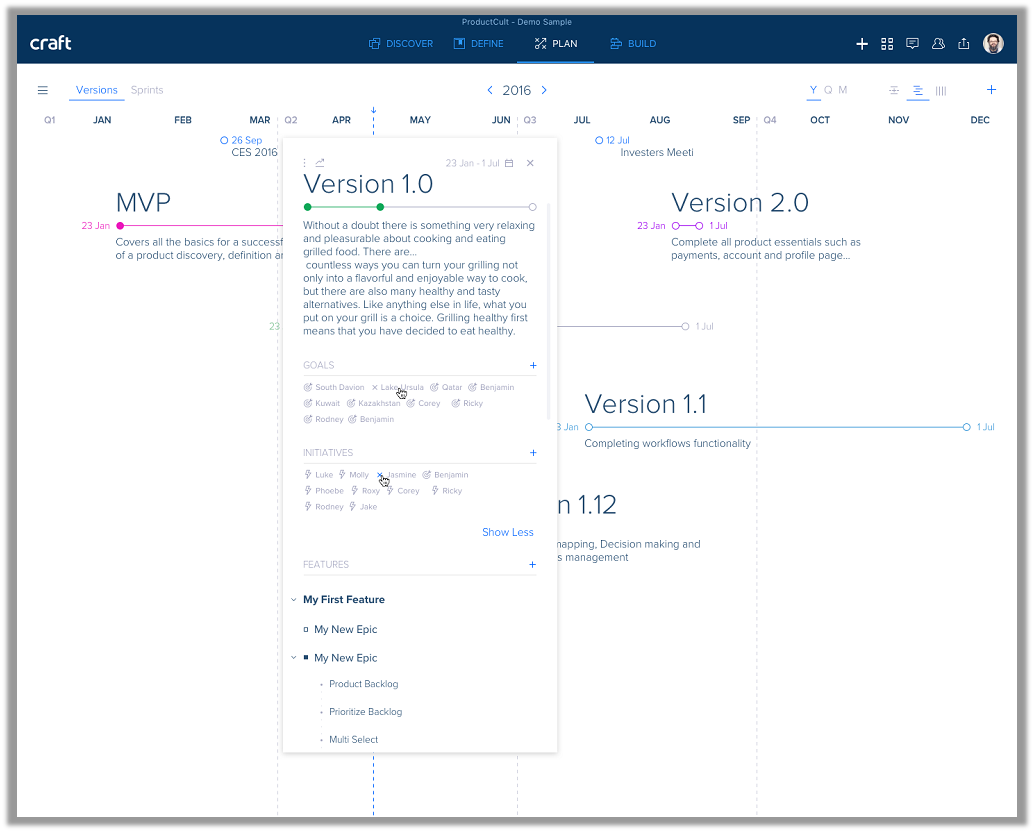Home > Blog > Team Craft’s Secret Sauce to Roadmapping
Team Craft’s Secret Sauce to Roadmapping

Getting your roadmap to communicate a product plan is no small feat. Most product teams struggle with trying to fit sprints into a reasonable time frame, meeting stakeholders’ deadlines and of course – prioritization.
This is the nature of agile teamwork, and there’s little anyone can do to change it. That’s also why we love it – the exciting, dynamic beat of things, keeping your ear to the ground, an ever shifting product ground beneath your feet.
For that reason, we need to be able to work with a roadmap that makes things simpler, not more complicated. We’ve talked to dozens of product managers and product teams over the past two years, and it looks like most agile teams are struggling with their product road maps way more than they should.

The best secret sauces always go back to basics
One reason is communication. When your roadmap always needs explaining and hand-holding, simply getting the message across to the team will literally take days. Another challenge we’ve encountered took us by surprise: it turns out that some product managers don’t always share product roadmaps with their product teams, which struck us as odd, because then how does the team know where it’s going?
At Craft, we of course eat our own dog food and use Craft roadmaps. That makes things astoundingly easier. So much so, in fact, that at some point we realized we were spending much less time fighting with roadmaps than some of our peers. So we set to work, trying to determine why that is, and here’s what we found out:
4 Essential tips to product roadmaps teams love
1. A strategic roadmap is a winning roadmap
It goes without saying that a product roadmap reflects its strategy, but how many product managers really consult with the product’s goals whenever updating the roadmap?
Those goals need to be the guiding principles of roadmap decision making, otherwise it’s dangerously easy to make “off-ish” prioritization decisions, and sprint-plan in a way that doesn’t stay true to the product vision.
2. Once you use visual product roadmaps, you can’t go back
Visualizing your roadmap serves multiple purposes, so let’s list only the most important ones:
- Visual roadmaps are much more intuitive to grasp, making them easier and quicker to understand. Your team members will thank you (except, maybe, the engineers)
- If your team members will thank you – stakeholders will be eternally grateful. While your team may be technically apt, your stakeholders most likely are not, and being able to visualize roadmap steps and time segments will speed up those conference calls amazingly.
- Multiple roadmaps – as established, visual maps are easier to take in at the same time than columns of numbers and dates. That goes double for roadmaps relating to multiple products.
3. Transparency: share and enjoy
One of the building blocks of a healthy agile process is “always be sharing”. Within the limits of sharing relevant data so as not to overwhelm team members, we have worked with full transparency from the get-go.
The roadmap is a culmination of all transparency, working on the product. It is essential that the team knows where we are, where we’re going, and why, every step of the way. An informed team is a more engaged team that cares more and wants to be more involved.
Visualization helps with that, but more important is access to the roadmap and understanding your place in the team effort. We solved that in Craft by creating a view of the roadmap that allows team members to see their own backlog, and which version everything is assigned to.
4. Expand your perspective – pursue different angles
Which brings us to the final ingredient in Craft’s Secret Sauce to Roadmapping Success: offer your users a wide variety of roadmap views. Different users have different needs at different times. Stakeholders will want to see overall activity throughout the year, while the R&D team needs to track separate versions in order to manage their tasks.
Here at Craft we offer free product roadmap samples in different formats (PDF, Powerpoint PPT or PDF)
We’ve managed to identify a select collection of views that together offers the full 360 degree perspective of what product teams need to know. Between release versions, backlog & sprint planning and several high-level views, you should be able to get a full picture of the product roadmap and everyone can see where they’re going.

Craft roadmap: sprint & backlog view

Craft roadmap: floating view, with open version
Summary
All in all, getting your roadmap to the level of clarity and coherence you need to communicate your product plan is easily manageable. If you insist on visualness, transparency, strategic planning and multiple perspectives – you should have a powerful visual tool that will help navigate the team forward toward the product vision.


